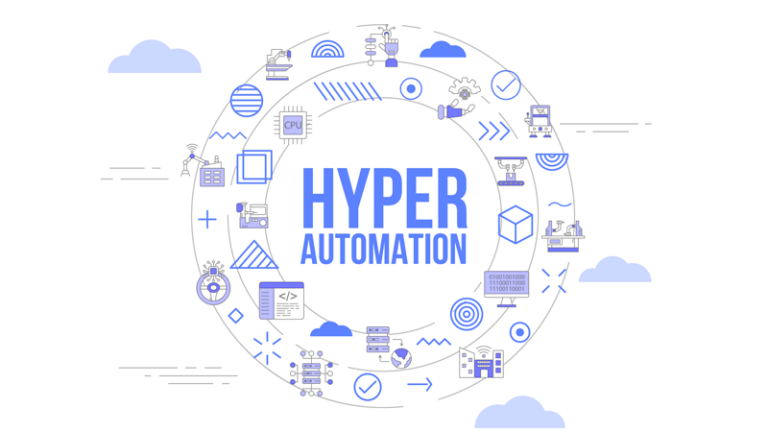To meet customer expectations and market demands, businesses are using various automation systems to cope with product quality. The process of hyperautomation in business processes may sound too technical, but it has multiple practical applications. According to Gartner, Hyperautomation is described as the combination of AI, RPA, and iBPMS along with automation processes (i.e. analyze, discover, design, measure, automate, track, monitor, and reassess) for enabling an AI-driven decision-making process. In this blog, we are going to elaborate on the role of Hyperautomation in business processes.
Table of Contents
What is Hyperautomation in Business?
Hyperautomation is defined as the process where automation technology is used for streamlining each business process by enabling repetitive processes without human intervention. It uses machine learning (ML), artificial intelligence (AI), and robotic process automation (RPA) for creating digital transformation and legacy processes. Hyperautomation in business also works in cross-functional teams while using additional intelligence for creating the best strategies for the completion of tasks. It helps companies in gaining cost-efficiency and better resource allocation while achieving more competitive benefits in the market.
Importance of Hyperautomation in Business Process
Hyperautomation in business works as a micro journey where each step is based on an effective, smarter, and hyperautomated approach for expediting the process and achieving business goals. It also allows the companies and their teams to collaborate and integrate the right technology and augment them properly for seamless and streamlined results. Now, let’s get started with the impact of hyperautomation in expediting business processes.
1. Increasing Business Efficiency
One of the most common uses of hyperautomation in business is for increasing the output. The automation system can easily delegate low-value repetitive work by allowing more people to dedicate more time to important tasks. It also enables the employees in building the business while having more agile and efficient decision-making abilities amongst themselves.
2. Improving ROI and Reducing Cost
With the integration of hyperautomation in business processes, improving profits while reducing costs becomes very simple. The financial benefits of the integration of automation tools and technologies not only increase business efficiency but also boosts revenue, employee productivity, morale, and an increased number of satisfied customers. Research from Gartner reveals that companies can reduce their operational cost by 30% with hyperautomation by 2024.
3. Enhancing Customer Service
Hyperautomation has a massive role in customer service as it automates the repetitive tasks that help the customer support representatives to focus on complex business functions. They delegate complex and time-consuming tasks to the bots and also collect customer data from their previous interaction. It helps the support agents to know the customer’s background and the issue, thus they can help the customers with better solutions quickly.
4. Accuracy & Acceleration
As hyperautomation allows complicated business processes to be automated, thus it improves the accuracy and speed of the business operations. Due to the huge usage of artificial intelligence, predictive analytics, deep learning, and natural language processing, end-to-end automation processes are possible nowadays. It allows the chatbots in replicating human intelligence by minimizing the chance of human weariness and error. As a result, the accuracy and acceleration of the operations increase a lot.
5. Better Workforce Engagement
By leveraging hyperautomation in business, it helps in speeding up the range of manual complex business operations of employees. It escalates the productivity of employees while automating the manual process that is done repetitively. Thus companies can allocate their resources effectively while doing better workforce management. It also ensures a significant increase in employee engagement, satisfaction, and enthusiasm.
6. Flexibility & Scalability
Since, with the advent of hyperautomation, companies work on a multitude of automation levels, they are using technologies that help them in achieving cost-efficiency and better workforce management. Organizations nowadays are not restricted to relying on the benefits of a single technology, but they can use multiple automation within inter-linked cross-functional teams. Thus, businesses can achieve more flexibility and scalability by harnessing hyperautomation in business processes.
7. Automate Integrations
Since businesses are using multiple levels of automation within their organizational levels, hyperautomation enables them to integrate different digital technologies seamlessly. It helps in the seamless integration of myriad tools across the legacy and business systems. It allows better access to the information and data across all employees and stakeholders within the organization.
Final Thoughts
To meet the global customer and market demands, businesses are inclining toward adopting the hyperautomation process. It helps in streamlining and personalizing the interactions which help in scaling up the customer experiences. However, hyperautomation is considered the next level of the automation journey of your company. It can bring together multiple facets of automation along with its tools and technology integration while unlocking the maximum power of automation. Trupp Global is a renowned outsourcing agency known for offering affordable customer support services. Trupp Global is harnessing the power of the latest tools and technologies that helps in delivering the best-in-class customer service suiting client requirements.

